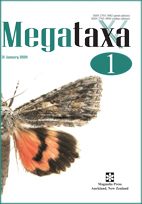Abstract
In proposing what might be the three leading questions in taxonomy, I have thought primarily about what might be the biggest barriers to taxonomists accurately describing the species on our planet and interpreting their phylogenetic relationships within a historical context. I have generally used the vernacular and examples of issues which I know as a dipterist (fly taxonomist). I apologize to my colleagues working on other groups but hope to be pardoned in the recognition that the problems identified below do appear to apply to our broader taxonomic community. 1. What are the impacts of the rapid rate of present day extinctions? 2. What is the future for taxonomists themselves? 3. What are some of the impacts of technology?
References
Borkent, A. (2018) The state of phylogenetic analysis: narrow visions and simple answers—examples from the Diptera (flies). Zootaxa, 4374 (1), 107–143.
https://doi.org/10.11646/zootaxa.4374.1.7
Borkent, A., Brown, B.V., Adler, P.H., Amorim, D.S., Barber, K., Bickel, D., Boucher, S., Brooks, S.E., Burger, J., Burington, Z.L., Capellari, R.S., Costa, D.N.R., Cumming, J.M., Curler, G., Dick, C.W., Epler, J.H., Fisher, E., Gaimari, S.D., Gelhaus, J., Grimaldi, D.A., Hash, J., Hauser, M., Hippa, H., Ibáñez-Bernal, A., Jaschhof, M., Kameneva, E.P., Kerr, P.H., Korneyev, V., Korytkowski, C.A., Kung, G.-A., Kvifte, G.M., Lonsdale, O., Marshall, S.A., Mathis, W., Michelsen, V., Naglis, S., Norrbom, A.L., Paiero, S., Pape, T., Pereira-Colavite, A., Pollet, M., Rochefort, S., Rung, A., Runyon, J.B., Savage, J., Silva, V.C., Sinclair, B.J., Skevington, J.H., Stireman III, J.O., Swann, J., Vilkamaa, P., Wheeler, T., Whitworth, T., Wong, M., Wood, D.M., Woodley, N., Yau, T., Zavortink, T.J. & Zumbado, M.A. (2018) Remarkable fly (Diptera) diversity in a patch of Costa Rican cloud forest: Why inventory is a vital science. Zootaxa, 4402 (1), 53–90.
https://doi.org/10.11646/zootaxa.4402.1.3
Brown, B.V., Borkent, A., Adler, P.H., Amorim, D.S. de, Barber, K., Bickel, D., Boucher, S., Brooks, S.E., Burger, J., Burington, Z.L., Capellari, R.S., Costa, D.N.R., Cumming, J.M., Curler, G., Dick, C.W., Epler, J.H., Fisher, E., Gaimari, S.D., Gelhaus, J., Grimaldi, D.A., Hash, J., Hauser, M., Hippa, H., Ibáñez-Bernal, S., Jaschhof, M., Kameneva, E.P., Kerr, P.H., Korneyev, V., Korytkowski, C.A., Kung, G.A., Kvifte, G.M., Lonsdale, O., Marshall, S.A., Mathis, W., Michelsen, V., Naglis, S., Norrbom, A.L., Paiero, S., Pape, T., Pereira-Colavite, A., Pollet, M., Rochefort, S., Rung, A., Runyon, J.B., Savage, J., Silva, V.C., Sinclair, B.J., Skevington, J.H., Stireman, J.O. III, Swann, J., Thompson, F.C., Vilkamaa, P., Wheeler, T., Whitworth, T., Wong, M., Wood, D.M., Woodley, N., Yau, T., Zavortink, T.J., Zumbado, M.A. (2018) Comprehensive inventory of true flies (Diptera) at a tropical site. Communications Biology, 1 (21), 1–8.
https://doi.org/10.1038/s42003-018-0022-x
Chapman, A.D. (2009) Numbers of living species in Australia and the world. 2nd Edition. Department of the Environment, Water, Heritage and the Arts, Australian Government, Canberra, 80 pp.
Cumming, J.M., Sinclair, B.J., Brooks, S.E., O’Hara, J.E & Skevington, J.H. (2011) The history of dipterology at the Canadian National Collection of Insects, with special reference to the Manual of Nearctic Diptera. The Canadian Entomologist, 143, 539–577.
Elias, S.A. (2010) Advances in Quaternary entomology. Developments in Quaternary Science 12, Van der Meer, J.J.M. (Ed.), xiv + 288 pp.
Erwin, T.L. (2004) The biodiversity question: how many species of terrestrial arthropods are there? In: Lowman, M. & Brinker, B. (Eds.), Forest canopies. Academic Press, London, pp. 259–269.
https://doi.org/10.1016/B978-012457553-0/50019-8
Hebert, P.D.N., Ratnasingham, S., Zakharov, E.V., Telfer, A.C., Levesque-Beaudin, V., Milton, M.A., Pedersen, S., Jannetta, P. & de Waard, J.R. (2016) Counting animal species with DNA barcodes: Canadian insects. Philosophical Transactions of the Royal Society B, 371, 20150333.
https://doi.org/10.1098/rstb.2015.0333
Hennig, W. (1966) Phylogenetic systematics. Translated by Davis, D.D. & Zangerl, R. University of Illinois Press, Urbana, Illinois, 280 pp.
Hoagland, K.E. (1996) The taxonomic impediment and the Convention of Biodiversity. Association of Systematics Collections Newsletter, 24 (5), 61–62, 66–67.
Lyal, C.H.C. & Weitzmann, A.L. (2004) Taxonomy: exploring the impediment. Science, 305, 1106.
https://doi.org/10.1126/science.305.5687.1106a
MacArthur, R.H. & Wilson, E.O. (1967) The theory of island biogeography. Princeton Univ. Press, Princeton, New Jersey, xi + 203 pp.
Mooi, R.D. & Gill, A.C. (2010) Phylogenies without synapomorphies—a crisis in fish systematics: time to show some character. Zootaxa, 2450, 26–40.
https://doi.org/10.11646/zootaxa.2450.1.2
Ramsay, G.W. (1986) The taxonomic impediment to conservation. The Weta, 9 (2), 60–62.
Semken, H.A., Miller, B.B. & Stevens, J.B. (1964) Late Wisconsin Woodland Musk Oxen in association with pollen and invertebrates from Michigan. Journal of Paleontology, 38, 823–835.
Williams, D.M., Ebach, M.C. & Wheeler, Q.D. (2010) Beyond belief, the steady resurrection of phenetics. In: Williams, D.M. & Knapp, S. (Eds.), Beyond cladistics: the branching of a paradigm. University of California Press, Berkeley/Los Angeles/London, pp. 169–195.
https://doi.org/10.1525/california/9780520267725.003.0010


